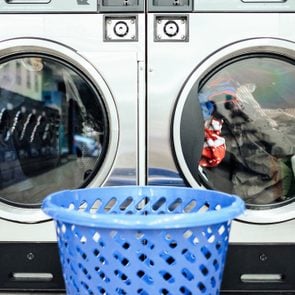How to Wash a Weighted Blanket the Right Way
Updated: Aug. 22, 2023
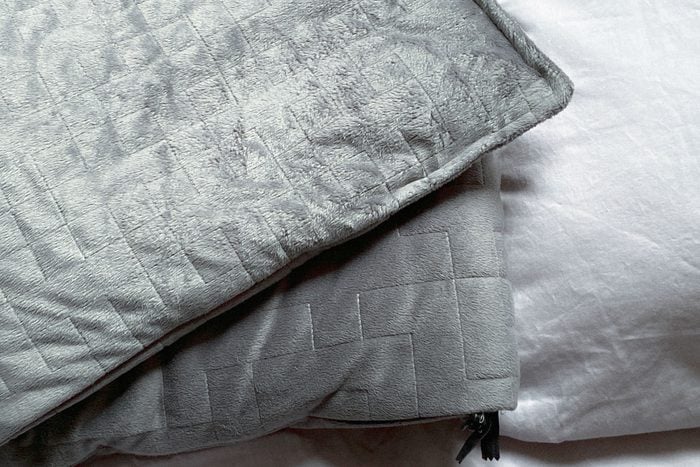
Experts share step-by-step instructions for how to wash a weighted blanket—and the best way to care for it
What’s more relaxing than a freshly made bed? Between the crisp fabric and the lovely fragrance, there’s hardly a more heavenly addition to a nighttime routine—especially if you add a weighted blanket to the equation. You know how often to wash your sheets, pillows and favorite throws, but do you know how to wash a weighed blanket?
Unlike typical bedding that can be tossed in the washer and dryer, weighted blankets require a bit more attention. To get up to speed on washing weighted blankets, we checked with our favorite laundry pros—and what they had to say surprised us.
Get Reader’s Digest’s Read Up newsletter for cleaning, humor, travel, tech and fun facts all week long.
What is a weighted blanket?
A great self-care gift, weighted blankets contain tiny beads, either glass microbeads, plastic pellets or (rarely) steel beads, that increase the weight of the blanket. According to Penn Medicine, weighted blankets use calm-inducing pressure therapy, which activates the parasympathetic nervous system to lower your heart rate when you’re stressed—kind of like a giant hug.
Ideally, the blanket should weigh 10% of the user’s body weight, plus one or 2 pounds more. So a 120-pound person would use a blanket that weighs around 14 pounds—10% plus 2 pounds. There are two types of weighted options: regular and cooling blankets. And take it from us, you can enjoy the blanket’s soothing benefits even if you’re sensitive to heat.
How often should you wash a weighted blanket?
The frequency of washing depends on how often the blanket is used, says Kristen Higgins, a consumer product testing expert for laundry at consumer goods company Henkel. “If you sleep with a weighted blanket every night, wash it once every few weeks to help prevent soils like sweat, bacteria and allergens from building up. However, if you just use it occasionally as a lap blanket while lounging, cleaning it a couple of times per year will do.”
Washing a weighted blanket is essential for maintaining cleanliness and overall longevity, says Higgins. “Just like pillows and other bedding, a weighted blanket can accumulate sweat, body oils, dirt and other debris over time. This may lead to unpleasant odors and potential bacterial growth. Regular washing helps ensure that the blanket remains fresh and comfortable.”
What to know before washing a weighted blanket
Since you probably learned how to do laundry before weighted blankets became popular, you’ll want to check out these tips before you get started.
- Washing instructions vary, so first check the care label’s laundry symbols or refer to the manufacturer’s guidelines on how to wash weighted blankets.
- Unlike washing waffle blankets and throw blankets, you must know the actual weight of the blanket before machine-washing it. According to Darenton Randall, a laundry scientist at Proctor & Gamble, smaller or lighter weighted blankets (those under 15 pounds) are ideal for machine-washing. Heavier and larger blankets require an extra measure of caution. Such weight can not only strain the washing machine, but it can also limit the blanket’s ability to get thoroughly cleaned due to restricted movement. In this case, it’s recommended to consult with a professional cleaner.
How to wash a weighted blanket
When your blanket gets stained or soiled, shows signs of wear or loses its fresh fragrance, it’s time to wash it. There are two ways to tackle this—in a washing machine or by hand.
How to wash a weighted blanket in the washing machine
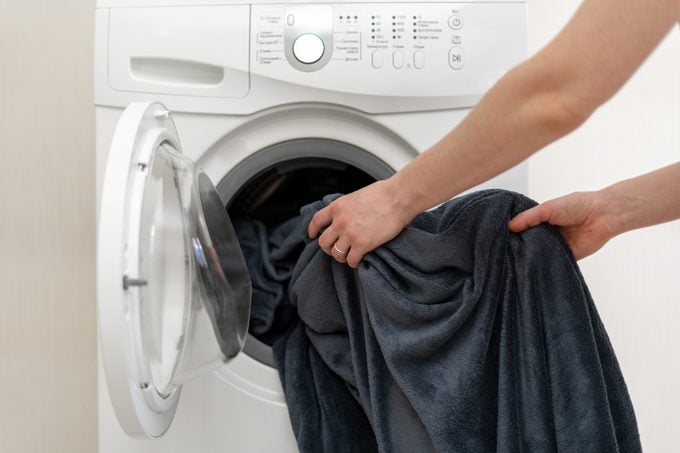
Most weighted blankets made from durable and washable materials, like cotton or polyester, can be machine-washed. To be sure, always follow the instructions on the care label. If it indicates that it’s machine washable, here’s how to do it—just make sure your washing machine is properly cleaned first.
Supplies
- Pre-treatment stain-removal spray for stubborn spots
- Toothbrush or small scrub brush
- Quality laundry detergent
Step 1: Remove any attachments
“Take off removable covers or ties before washing to prevent damaging or tearing the blanket,” says Higgins. This will also ensure the blanket gets a thorough cleaning.
Step 2: Pre-treat stains
If there are any visible stains, spot-treat them with a toothbrush and some store-bought detergent, homemade laundry detergent or a pre-treatment spray before washing. Follow directions on the cleaning product label.
Step 3: Add laundry detergent
Add a quality laundry detergent to the washer, according to the washer manufacturer’s guidelines. Do not use bleach, which can destroy the fibers of the blanket as well as the color. And do not use fabric softener. “Fabric softener can add extra weight to the blanket and affect its functionality,” says Higgins. As the fabric softener builds up on the fibers of the blanket, it stiffens them, and you lose that softness that feels so good against your skin.
Step 4: Select the washer settings
Use a gentle or delicate wash cycle and the slowest spin cycle to minimize wear and tear on the fabric and stitching. Unless otherwise directed on the care label, use cool water when washing a weighted blanket.
Step 5: Load the washer
If you already know how to separate laundry, you’ve likely guessed that weighted blankets should be washed alone due to their size and weight. First, check the owner’s manual for the weight limit of your washing machine (typically up to 20 pounds) before tossing in your weighted blanket. Blankets that are more than 20 pounds should be washed in a commercial machine at a laundromat because the additional weight of the blanket could damage your machine. Plus, if the blanket is so large that it cannot move freely in the washer, it won’t get adequately cleaned.
For top-loading washers, add detergent to the drum before loading the blanket. Evenly distribute the weighted blanket around the washer to ensure better weight balance. If you hear the washer go off balance, pause the cycle and redistribute the blanket. If you have a front-loading washer, add detergent as usual.
Step 6: Rinse thoroughly
To ensure the blanket is thoroughly rinsed, select the maximum water level. If you see soap residue or bubbles on the blanket at the end of the cycle, run the rinse cycle again.
How to wash a weighted blanket by hand
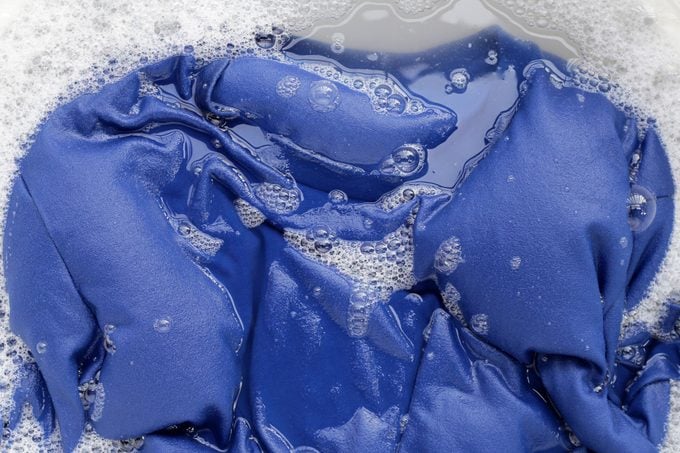
You’ll want to hand-wash your blanket if it’s made of delicate or sensitive materials, has intricate designs or delicate fillings, or if the care instructions don’t permit machine-washing. “Washing by hand allows for better control over the cleaning process and minimizes potential damage to the blanket,” says Higgins. “But be sure to put some elbow grease into it to get a deep clean.”
Supplies
- Pre-treatment stain-removal spray for stubborn spots
- Toothbrush or small scrub brush
- Quality laundry detergent
Step 1: Spot-treat stains
Just as you would before machine-washing, you’ll want to remove visible stains with a brush and mild detergent or stain remover following product directions.
Step 2: Prepare a bath
If you know how to hand-wash clothes, it’s pretty much the same for weighted blankets—just super-sized. First, fill a large tub or basin with lukewarm water and a quality laundry detergent. Swirl the water to distribute the detergent evenly.
Step 3: Submerge, soak and agitate
Place the weighted blanket in the water and gently move it back and forth to ensure even cleaning. Allow the blanket to soak for 15 to 30 minutes, occasionally agitating it with your hands.
Step 4: Rinse thoroughly
Drain the soapy water and refill the tub with clean water for rinsing. Repeat until rinse water is clear and all detergent is removed. And remember: Never use fabric softener.
How to dry a weighted blanket
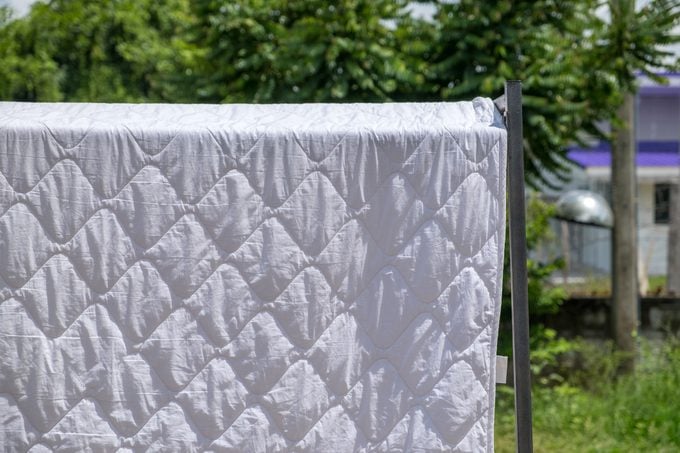
“It is equally essential to inspect the care label for drying instructions,” says Randall. There are two options for drying a weighted blanket—machine-drying and air-drying.
Machine-drying
If the care tag allows machine-drying, place the weighted blanket in the dryer on low heat or the tumble dry setting—and make sure you know how to select the best dryer settings. Ensure that there is ample room for proper air circulation. Rearrange the blanket every 15 to 20 minutes so all sides are properly dried in the machine. When dry, Randall recommends that you re-fluff the blanket as it may flatten during cleaning.
If machine-drying, never use dryer sheets. Like fabric softener, they can add extra weight to the blanket and affect its softness.
Air-drying
To air-dry a weighted blanket, spread it out on a clean, dry surface or hang it over a banister, table or clothesline so it won’t crease or change its shape. Turn the blanket over every four hours to help it dry quicker and more evenly. Be prepared—it usually takes one to two days to completely air-dry a weighted blanket. When it’s completely dry, Randall recommends fluffing it.
Can you dry-clean a weighted blanket?
Before bringing your weighted blanket to a dry cleaner, check the care tag to make sure it’s able to be dry-cleaned. While most weighted blankets can be washed at home or at a laundromat, some require special dry cleaning based on the fabric and materials.
How to care for your weighted blanket
Consider using a removable duvet cover on the weighted blanket to protect it from dirt and spills. These covers can be removed and washed more easily than the blanket itself, says Higgins.
Spot-clean the blanket as needed, and use a lint roller once a week, or more often if necessary, to remove pet hair. Store the blanket folded on a shelf or rolled in its storage bag.
About the experts
- Kristen Higgins is a consumer product testing expert with 17 years of research and development experience in laundry, home and beauty products. She is a Henkel principal scientist in performance testing.
- Darenton Randall is a Tide scientist and fabric care consultant at Proctor & Gamble with more than nine years of experience in content and media marketing. Randall is frequently tapped by national media to share his expertise on laundry-related problems.
Source:
- Penn Medicine: “4 Ways Weighted Blankets Can Actually Help You”

